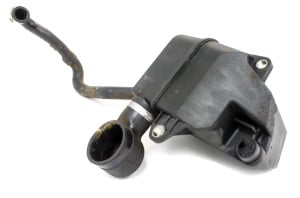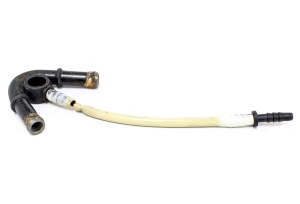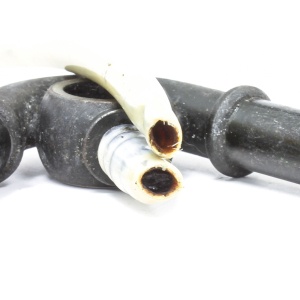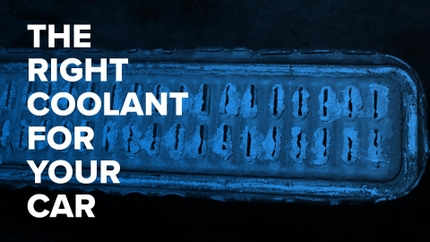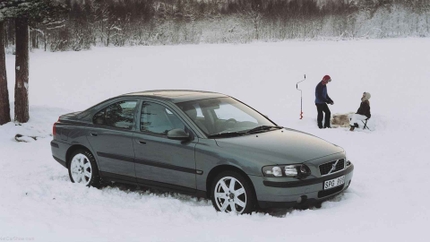- 11/09/2017
- 2 Min Read
- By: Jay VanGorden
Volvo S60 PCV Breather Box Guide - Symptoms and Diagnosis
Hello From Sweden!
We decided to give our 2004 Volvo S60 content car the famous "PCV Glove Test," where you remove the oil cap and slip a rubber glove over in its place. The PCV system should ideally have negative pressure so if you start your engine and the glove inflates, well, you've got yourself a problem.

The problem:
What we typically find on these engines is that over time your PCV system can become clogged due to infrequent oil changes and/or low quality engine oil. When this happens, your engine can start to consume engine oil, and in some severe cases it can even start to push out engine seals such as camshaft and crankshaft seals (the result of pressure buildup in the engine). Below you can see some carbon blockage at the bottom of the breather box where it enters the engine block.
Additionally, you can see the hard plastic hose from the PCV nipple has been completely clogged solid. In some cases, this hose can even snap off. We cut this hose in half for demonstration purposes. If you look closely, you can actually see that the entire hose is clogged.
So what exactly is a PCV breather system?
A PCV (positive crankcase ventilation) breather system is designed to regulate hazardous waste from your vehicle. As your engine runs, combustion gases escape from the combustion chamber, finding their way into the crankcase of your engine. This unused combustion gas, also referred to as "blow-by," can be a major cause of smog. A PCV system prevents pollutants from escaping into the environment, and vehicle manufacturers started fitting engines with a PCV valve to ensure that gas remains contained within your vehicle. In naturally aspirated engines, the PCV valve connects the crankcase to the intake manifold. It does this from a location nearly opposite of the breather location. This connection creates a slight vacuum in the crankcase that draws gasses in a direction from the breather into the intake manifold and through the PCV valve, where they are re-burned with a fresh charge of air.
What causes the engine oil to thicken and leave behind deposits or sludge in my engine?
- Wrong oil grade, quality and/or viscosity
- Vehicles driven too many miles between oil changes
- Vehicles frequently driven short distances with many cold starts
- Excessive idling
- Fuels of low quality or with high alcohol content
- Additives added to oil or fuel
- High ambient temperature
- High air humidity
What are some of the symptoms I can expect if my breather system is clogged?
- Illuminated oil pressure lamp due to clogged oil suction strainer to oil pump or oil filter.
- Illuminated Check Engine Lamp due to incorrect engine fuel trim level parameters.
- Noise (whistling) due to high pressure in crankcase. This noise will stop if the oil filler cap is removed.
- Poor Drivability. Clogged crankcase ventilation can reduce the engine performance.
- Uneven/oscillating idling caused by clogged crankcase ventilation.
- Oil leak from engine seals due to restricted crankcase ventilation.
- Noise (knocking). Low oil pressure can cause premature bearing wear and lead to internal engine component failure.
- High oil consumption/noise from turbo. Damaged bearing or seals in the turbo can cause these symptoms. Chances are you'll know you have a problem at this point as you’ll either have no boost, blue smoke will be pouring out the tail pipe, or both.
What can I do to check for it?
- The first step is to inspect the oil filter to see if it is abnormally dirty. An abnormally dirty filter is easily recognized by its thick, black deposits.
- If the engine has a problem with carbon deposits, the passageways in the engine block and oil trap may be completely or partially clogged. Remove and check the oil trap, hoses and their passageways in the engine block. There should not be any major collections of carbon deposits in the hoses or in the passageways in the block.
- Drain the engine oil. Remove the oil pan and check the oil pan and crankcase for deposits. Normally, there should not be any deposits. Also check the oil suction strainer on the oil suction line for contaminants and deposits.
- Use a low caliber vacuum gauge to check for positive pressure through the dipstick tube.
Where can I find a PCV Kit For my Volvo?
Simple, you can find all of the Volvo PCV Kits on our site, fcpeuro.com
Looking to service your Volvo PCV system yourself?
See our DIY video here:

